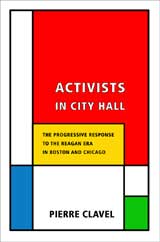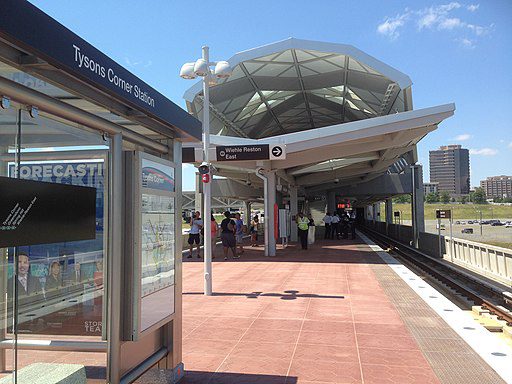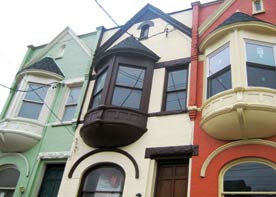Having studied the “progressive city” with Professor Pierre Clavel in the early 1990s, I welcomed the opportunity to read his latest work on this topic. It has been the primary focus of his research for many decades, including through his recent retirement from the Cornell City and Regional Planning Department.
The book takes the reader back to the mayoral administrations of Ray Flynn in Boston and Harold Washington in Chicago, primary through the eyes of activists who joined these administrations and attempted to forge progressive change from the inside. Reading this book during the lead up to the midterm elections, I found myself wondering if there were any lessons for the Obama administration and for the many organizers who thought progressive change would happen once “their guy” was in office.
Clavel’s definition of a progressive city includes the following elements: a social movement base supporting a mayoral candidate; a redistributive vision of government’s role; development and implementation of innovative policies; reforms that open up government to broader representation, especially by the poor and people of color; and long-term impact that often extends beyond the mayor’s tenure. Further, the relationship between city hall and local communities is such that “each [is] responsive to initiatives from the other.”
For Clavel, the story of social movement and that of redistributive government are distinct but related. He admits at the end of the book that his perspective is heavily based on the accounts of “key informants within city hall.” He hoped that the perspective of neighborhood activists would act as a check, but perhaps wisely he didn’t seek to reconcile differing viewpoints. My sense is that he gave greatest weight to the views of the insiders. Yet his book does show, particularly in Boston, how some community leaders grew frustrated with the mayor over time as some of their demands went unmet.
In Boston, the key community development and planning innovation was linkage, whereby resources were set aside from big downtown developments to fund affordable housing. In Chicago, a series of industrial and manufacturing retention policies attempted to stem the tide of factory closings and job loss. Minority contracting practices opened up new avenues for employment among women- and people of color-owned businesses.
One of the shortcomings of the book is its failure (by Clavel’s own admission) to show strong evidence of the impacts of some of these policies. Clavel does provide data on housing development in Boston, demonstrating that production grew during the Flynn administration. But the evidence of job retention and creation in Chicago proved much harder to document. To me this highlights the more general challenge organizers and progressive leaders sometimes face proving their successes. For example, look at Obama and the congressional Democrats: how well did they tout the benefits of what they had accomplished after two years in power?
These concerns aside, the interlinked stories of social movement and progressive governance make for a fascinating read. Clavel provides a fair amount of background on some of the major community leaders and organizing efforts that preceded each mayor’s election to office, including a description of Mel King’s alternative economics movement in Boston and Alinsky’s organizing of The Woodlawn Organization in Chicago. The book includes accounts of and by a veritable who’s who of progressive planning, including Bennett Harrison, Gus Newport, Peter Dreier, Janice Fine, Rob Mier, Bob Giloth, and Kari Moe.
Some of the most engaging passages describe how various community leaders came together to generate innovative policy ideas that fed into the new administrations. This funneling of ideas was aided by the fact that Flynn and Washington each brought community organizers into their fold from the get-go. Flynn hired leaders from Mass Fair Share, Massachusetts Tenants Organization, and other local groups, and they were referred to as the “Sandinistas.” Yet he appointed outsiders and more conservative people to important posts as well. Flynn’s campaign manager, Ray Dooley, also took a key position, and according to fellow colleague (and NHI board member) Peter Dreier, “Ray was an organizer … What made the Flynn administration so effective was that it was like a permanent organizing campaign.”
In Chicago, the Community Workshop on Economic Development developed a platform of “jobs, not real estate” and other proposals that became the basis of Washington’s campaign platform when he ran for mayor. He then hired several community activists who had been part of the CWED project. Washington, like Flynn, sought diversity of opinion and included members of the business community among his top advisors along with those “to the left of liberal.”
Having community leaders in their administrations helped ensure that Flynn and Washington were responsive to neighborhood needs and would carry out at least some of the neighborhoods’ agenda. Yet there are also stories of community efforts that failed to sway the administrations, even with progressive voices on the inside. It is interesting to note that community leaders in both cities pushed for the establishment of neighborhood councils and other mechanisms to open up political participation further. Yet Flynn and Washington instinctively feared that ceding such control could backfire, and sought alternative ways to invite civic engagement.
Washington was trying to dismantle 30 years of the Daley machine and didn’t want to risk that neighborhood councils would be co-opted by the aldermen who opposed him. So instead he established as many as 100 “delegate agencies” in the wards and funneled CDBG money to them. Flynn proceeded cautiously and eventually did establish neighborhood councils, but refused to give them veto authority over development. They had mixed success, and one advocate noted that fighting development plot-by-plot, rather than setting fairer ground rules citywide, was just too labor intensive to sustain.
While each administration failed, perhaps inevitably, to live up to the hopes of neighborhood activists, Clavel sees significance in the fact that each mayor challenged the normal pro-growth machine of real estate interests. Placed in the larger context of Reagan-era politics, he finds these redistributive and participatory reforms all the more impressive. Both tried to go even further but were stymied by city councils that shot down policies deemed too radical, such as strong rent control provisions in Boston.
Yet the two mayors were adept at channeling funds to the neighborhoods, contributing to the expansion and professionalization of the CDC infrastructure. Clavel notes in both cities the evolution of some groups away from activism to services and development, reflecting a broader trend that has led to much soul searching about whether CDCs should reembrace organizing and whether organizing groups can also provide services — a debate that continues today (see Shelterforce #161). He sees the potential harms to communities when progressive city halls siphon off neighborhood leaders and co-opt organizations with an influx of funding, thereby weakening the very base needed to fight for continued reform.
Clavel also tackles the thorny issue of race. In Boston, racial schisms, the recent “trauma of busing,” and Mel King’s call for black economic and political autonomy were a backdrop for, and contrast to, Flynn’s insistence that the problem was not racism but economic discrimination, to be solved by redistributing downtown profits into the neighborhoods. Clavel concludes, “This may have played well in white neighborhoods, but blacks found it facile.”
The Harold Washington story is particularly poignant and echoes today. A man becomes the first black mayor of Chicago, and two stories are told of his legacy. One is of hope renewed. Clavel quotes community activist Doug Gills on the election victory: “There was something beautiful about it, and something that brought the dead to life. People who had been dead since the 1960s, not in a physical sense but emotionally, spiritually dead, came alive! I saw and worked with winos who put on ties and picked up their pens and clipboards and walked precincts during the Harold Washington campaign.” A core group of racially diverse leaders in his administration sought to address race head on, opened up decision making to those who had been shut out by the machine, and worked across racial lines. The other story is about “the coming of a dark age” for much of white Chicago and the city’s elites, who saw no good in Washington. A Clavel source cites polls showing that very few whites or blacks saw racial healing from the Washington years; in fact many thought racial divisions worsened.
Today we have the first African-American president of the United States, elected with the help of many people who had also been “dead emotionally” but awoke to the possibility of a transcendent leader. And we have at least two very different stories of his legacy to date. Yes, we could have predicted that, like Flynn and Washington, Obama wouldn’t be able to implement substantive reforms quickly enough to appease the “left of liberal” in his base. But should we have predicted that the same sort of ugly, deep-seated, racially tinged hostility that Washington faced would emerge in the form of the Tea Party?
What could Obama have learned (and could still learn) from these local leaders about staying in campaign mode while governing, continuing to organize, and having organizers among the inner circle? What could he have anticipated about the backlash that comes from breaking the race barrier? Clavel’s stories of 1980s urban progressivism definitely still resonate today.






Comments